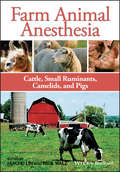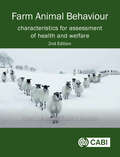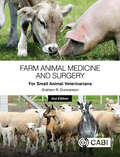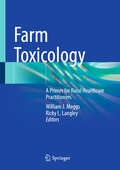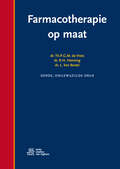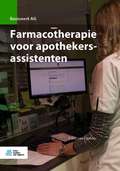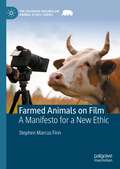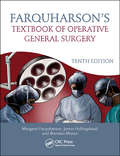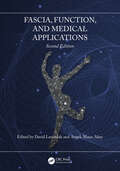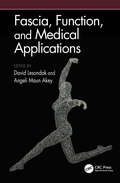- Table View
- List View
Famous First Papers for the Neurointensivist
by Eelco F.M. WijdicksA major contribution to the literature in neurology from renowned neurointensivist Eelco F.M. Wijdicks, MD, PhD, Famous First Papers for the Neurointensivist presents and critically assesses numerous papers that have made a profound impact on the diagnosis and treatment of neurologically acute conditions. In general, there has been little historical work in acute neurologic conditions, precisely because neurology is not perceived through this perspective. Famous First Papers for the Neurointensivist addresses this problem by a scholarly treatment of early descriptions of clinical signs, syndromes and presenting the development of treatment of these acute disorders. Using a uniform and easy-to-read format, the title offers a clear reproduction of each paper's title page, a short historical note, and a brief discussion and its implications, and a final comment to provide perspective. Landmark clinical trials that apply to acute neurology are included, and the book also briefly discusses the birth of intensive care units. Ground-breaking and indispensable for all physicians and researchers interested in neurocritical care, Famous First Papers for the Neurointensivist is a unique, original reference, providing not only a single source for discovering the most important papers in the field but also a critical analysis of the impact of each paper on the development of neurocritical care. Dr Wijdicks has been integral to the growth and development of neurocritical care as a specialty. He has cultivated it firsthand, serving as a contemporary of Raymond Adams, C. Miller Fisher, and Allan Ropper, all pioneers in acute neurological care. He established the neurocritical care program at the Mayo Clinic in the early 1990s and has served as the editor in chief of the journal Neurocritical Care, which was first published in 2004 after the foundation of the Neurocritical Care Society. His unique vantage point allows him to bring us a book that few others could produce, Famous First Papers for the Neurointensivist. This book is an original in the field and should be on the reading list of anyone who cares for critically ill neurologic and neurosurgical patients... Reading this book from cover to cover is highly recommended. The writing is clear and concise, and the transitions are smooth. Each essay is self-contained and allows the reader to set his or her own pace. Once completed,the book serves as a great reference book because each essay stands on its own. The photographs of the manuscripts' title pages and key tables and figures are of high quality, and a translation is provided if the original work was not in English... Dr Wijdicks has sifted through the library stacks and has emerged with a book that puts the specialty of neurocritical care into historical perspective. In order to know where you are going, you must first know where you have been. This holds especially true for neurocritical care because the specialty continues to grow and flourish. -- JAMA NEUROL/VOL 70 (NO. 4), APR 2013 WWW. JAMANEURO.COM
Fancy Feet
by Heidi CaveA team of firefighters fought to save Heidi's life after a horrific accident that killed her best friend, burned over 53 percent of Heidi's body, and claimed both her legs. The following year followed countless surgeries, surviving, pain management, fighting, and loss. Until she finally faces the driver who changed her life, Heidi realizes she has one last hurdle: forgiveness.Heidi Cave is a well-respected advocate for burn survivors and amputees, and serves on a board of advisors for the BC Professional Fire Fighters' Burn Fund's efforts to build a research laboratory and treatment center in Vancouver.
Farm Animal Anesthesia
by Paul Walz Huichu LinFarm Animal Anesthesia: Cattle, Small Ruminants, Camelids, and Pigs presents practical guidance on using anesthetic and analgesic drugs to prevent pain caused by surgery or disease. This cohesive resource offers complete coverage of anesthetics and anesthetic techniques in farm animals with a focus on practical applications. Providing thorough information on pain management and residues, the book also covers specific techniques for common surgical procedures and considerations for animals with pathophysiological conditions.The book includes chapters on preanesthetic considerations, anesthetic drugs, chemical restraint and standing sedation, injectable anesthesia, inhalant anesthesia, local techniques, specific procedures, pain management, residues, and euthanasia. Farm Animal Anesthesia is a useful guide for farm animal practitioners, veterinary students, and researchers working with these species.
Farm Animal Anesthesia: Cattle, Small Ruminants, Camelids, and Pigs
by HuiChu Lin Thomas Passler Stuart Clark-PriceA completely revised and updated reference for farm animal anesthesia, sedation, and pain management In the newly revised Second Edition of Farm Animal Anesthesia: Cattle, Small Ruminants, Camelids, and Pigs, distinguished veterinarians Drs. HuiChu Lin and Paul Walz deliver a practical and easy-to-use manual for techniques associated with anesthesia and pain management in farm animal species. The authors incorporate advances in surgical and diagnostic techniques, with the latest drugs and equipment, updated images, and new technique descriptions added throughout the book. Reflecting their newfound popularity, Farm Animal Anesthesia offers additional and updated information on drug combinations and anesthetic techniques relevant to small ruminants and potbellied pigs. New chapters and topics on paralytic drugs for complete muscle relaxation, ventilators for advanced orthopedic and ophthalmological surgeries, updated local and regional anesthetic techniques, and comprehensive standing surgery and diagnostic procedures have been added. Readers will also enjoy access to a companion website with video clips demonstrating techniques described within. The book also includes: A thorough introduction to general preanesthetic considerations for ruminants, camelids, including alpacas and llamas, and potbellied pigs A comprehensive exploration of commonly used preanesthetics and injectable anesthetics, including anticholinergics, sedatives, tranquilizers, analgesics, and injectable anesthetics Practical discussions of standing sedation and chemical restraint, including new drug combinations for reliable restraint and remote drug delivery In-depth treatments of the use of neuromuscular blocking drugs and monitoring in farm animals Perfect for farm animal practitioners, veterinary surgeons, veterinary anesthetists, and researchers, Farm Animal Anesthesia is also an indispensable resource for veterinary students and residents in surgery and anesthesia seeking a one-stop, practical reference to farm animal anesthesia.
Farm Animal Behaviour
by Ingvar EkesboAnimal behaviour is the basis for ascertaining their welfare and is a topic of ever growing importance. This textbook is organised into three sections covering all major farm animals of the world, both mainstream and specialist: large farm animal species (horses, cattle, swine, sheep and goats), poultry and farmed birds and non-domesticated animals such as deer. Each chapter describes the elements of behaviour of a particular species in a clear and uniform format. Background to domestication, innate and learnt behaviour, social behaviour, mating behaviour, activity patterns, senses, behaviour in the young animal, vision and hearing are all covered for each species. Understanding of ethological knowledge is both a necessary aid for getting correct diagnoses, but also for the assessment of health and welfare in the single animal or a group of animals, making the book valuable for veterinary practitioners as well as students at university and tertiary level.
Farm Animal Behaviour: Characteristics for Assessment of Health and Welfare
by Ingvar Ekesbo Professor Stefan GunnarssonCompletely updated and revised, Farm Animal Behaviour 2nd Edition continues to provide essential information on normal and stereotypic behaviours in a wide variety of farm animals to help in the assessment and diagnosis of their health and welfare. Comprehensive coverage of a range of farmed animals from: horses, cattle, sheep, goats and pigs through to domesticated poultry, deer, ostrich and many other species. Innate, learned and social behaviours are described together with activity, vision and hearing to build a picture of normal behaviours presented in a clear and consistent way for each species. Stereotypic behaviours, injuries and disease, resulting from improper management practices, are outlined in detail. For the second edition Professor Stefan Gunnarsson joins the author team and contributes his long-standing knowledge, clinical and scientific expertise. Many new snapshot photographs in full colour throughout have been added to further illustrate behaviours as they occur. New information on normal and stereotypic behaviours is included. The explosion in new research is captured with a wealth of new references and pointers for further reading. A consistent approach to each species allows for easy comparison. Farm Animal Behaviour 2nd Edition provides a comprehensive yet concise background for all students, postgraduates and practitioners in veterinary medicine, animal science, welfare and ethology.
Farm Animal Behaviour: Characteristics for Assessment of Health and Welfare
by Ingvar Ekesbo Professor Stefan GunnarssonCompletely updated and revised, Farm Animal Behaviour 2nd Edition continues to provide essential information on normal and stereotypic behaviours in a wide variety of farm animals to help in the assessment and diagnosis of their health and welfare. Comprehensive coverage of a range of farmed animals from: horses, cattle, sheep, goats and pigs through to domesticated poultry, deer, ostrich and many other species. Innate, learned and social behaviours are described together with activity, vision and hearing to build a picture of normal behaviours presented in a clear and consistent way for each species. Stereotypic behaviours, injuries and disease, resulting from improper management practices, are outlined in detail. For the second edition Professor Stefan Gunnarsson joins the author team and contributes his long-standing knowledge, clinical and scientific expertise. Many new snapshot photographs in full colour throughout have been added to further illustrate behaviours as they occur. New information on normal and stereotypic behaviours is included. The explosion in new research is captured with a wealth of new references and pointers for further reading. A consistent approach to each species allows for easy comparison. Farm Animal Behaviour 2nd Edition provides a comprehensive yet concise background for all students, postgraduates and practitioners in veterinary medicine, animal science, welfare and ethology.
Farm Animal Medicine and Surgery
by Graham R DuncansonSmall animal veterinarians are increasingly taking on caseloads that include farm animals, with cases being presented by local hobby farmers, smallholders, and 'novelty pet' owners. Recognising this trend, this book provides a quick reference guide for small-animal orientated veterinarians in the basics of surgery and treatment of farm animals. Popular animals such as cattle, sheep, goats, camelids and backyard poultry are covered, and basic techniques such as anaesthesia, clinical examination techniques, breeding, surgery and euthanasia are discussed. This book provides a quick-reference format, ideal for looking up information during a consult, useful for veterinarians in small and mixed practices and those less familiar with animals such as alpacas which have seen an increase in popularity. Also ideal as a refresher guide and as a continuing professional development resource.
Farm Animal Medicine and Surgery for Small Animal Veterinarians: For Small Animal Veterinarians
by Dr Graham R DuncansonSmall animal veterinarians are increasingly taking on caseloads that include farm animals, with cases being presented by local hobby farmers, smallholders, and 'novelty pet' owners. With the increase in veterinary telemedicine, they now also receive requests for advice electronically from owners further afield. Recognising this trend, this book provides a quick reference for small-animal orientated veterinarians in the basics of surgery and treatment of farm animals. Popular animals such as cattle, sheep, goats, pigs, camelids and backyard poultry are covered, and basic techniques such as anaesthesia, clinical examination techniques, breeding, surgery and euthanasia are discussed. This new edition: - Expands on recent developments in all areas of medicine and surgery, covering advances such as the increased use of ultrasound across species and adding a new section on anthelmintics. - Provides updates on current major disease threats, as well as providing a One Health perspective. - Includes full colour images to help bring the subject to life. Ideal for looking up information during a consult, or for use as a refresher guide and continuing professional development resource, this book is an important tool for veterinarians in small and mixed practices.
Farm Animal Medicine and Surgery: For Small Animal Veterinarians
by Graham R DuncansonSmall animal veterinarians are increasingly taking on caseloads that include farm animals, with cases being presented by local hobby farmers, smallholders, and 'novelty pet' owners. Recognising this trend, this book provides a quick reference guide for small-animal orientated veterinarians in the basics of surgery and treatment of farm animals. Popular animals such as cattle, sheep, goats, camelids and backyard poultry are covered, and basic techniques such as anaesthesia, clinical examination techniques, breeding, surgery and euthanasia are discussed. This book provides a quick-reference format, ideal for looking up information during a consult, useful for veterinarians in small and mixed practices and those less familiar with animals such as alpacas which have seen an increase in popularity. Also ideal as a refresher guide and as a continuing professional development resource.
Farm Toxicology: A Primer for Rural Healthcare Practitioners
by William J. Meggs Ricky L. LangleyThis book provides healthcare workers practicing in rural areas with the practical knowledge necessary to diagnose and treat farm workers who develop an acute or chronic illness. In rural settings, distances and travel times may be prolonged, leading to delays in assessment and definitive treatment. Healthcare providers must be prepared to rapidly assess the ill farm worker, formulate a differential diagnosis, and initiate treatment. The volume begins by teaching the reader to formulate a comprehensive differential diagnosis of farm worker illnesses, including stings and bites, green tobacco syndrome, infections, and heat and weather-related events, as well as exposures to the numerous chemicals found on the farm. The toxicity of various farm products, such as insecticides, herbicides, rodenticides, and petroleum products, are each discussed in their own chapter, enabling the reader to rapidly obtain vital information on their mechanism, clinical signs and symptoms, and differential diagnosis. The reader will learn to utilize information on pesticide labels and safety data sheets, including proper use of personal protective equipment. Chapter authors discuss a variety of other topics, including toxic gas exposures on the farm, disease associations with chronic chemical exposures, illicit drug use, and miscellaneous conditions that a rural practitioner should be familiar with that may occur on the farm, such as heat and cold injuries, lightning strikes, allergies, and asthma. Farm Toxicology: A Primer for Rural Healthcare Practitioners will be an invaluable resource for rural healthcare providers, including paramedics, triage nurses, physician assistants, nurse practitioners, and physicians, who need to quickly evaluate and treat ill farm workers.
Farmacologie
by J.M.A. Sitsen A. F. Cohen K. L. Franson P. Smits H.A.J. Struijker Boudier L.M. van BortelFarmacologie voorziet bij uitstek in de behoefte aan een Nederlandstalig leerboek dat aansluit bij de Nederlandse geneeskunde. In dit leerboek wordt het klinisch belang van de leerstof uitgebreid toegelicht en benadrukt.Farmacologie biedt een overzicht van de belangrijkste onderwerpen uit de medische farmacologie. In de tekst zijn kaders met trefwoorden opgenomen, waardoor de student zich de termen en onderwerpen gemakkelijk eigen maakt. Bovendien wordt het geheel van de stof hierdoor overzichtelijker.Farmacologie is een medisch vakgebied dat voortdurend in beweging is en ook in de toekomst een belangrijke rol zal spelen. Daarom is in dit boek naast de leerstof ook leesstof opgenomen, waarin zowel naar de geschiedenis wordt gekeken als gespeculeerd wordt over de toekomst van de farmacologie. Het boek is geheel bijgewerkt naar de huidige stand van zaken. Nieuwe inzichten en geneesmiddelen zijn opgenomen en er is ook aandacht besteed aan weesgeneesmiddelen en monoklonale antilichamen. Het boek is uitgebreid geïllustreerd met full-color figuren van het Teaching Resource Centre van de Universiteit Leiden. Aan deze druk is een onlineomgeving toegevoegd: Studiecloud. De lezer kan via deze internetsite voortdurend beschikken over dit aanvullende materiaal zoals extra oefenvragen, samenvattingen en deep links met betrouwbare informatie, samengesteld door de auteurs van het boek.
Farmacotherapie op maat
by R. H. Henning Th.P.G.M. de Vries L. M. van BortelFarmacotherapie heeft de optimale behandeling van patiënten met geneesmiddelen tot doel; er wordt gestreefd naar farmacotherapie op maat. De kennis van ziekten en geneesmiddelen is aanzienlijk gegroeid, evenals het aantal geneesmiddelen. Enerzijds is daardoor therapie op maat beter mogelijk, anderzijds maakt dat het keuzeproces complexer. Formularia, protocollen en standaarden bieden houvast, maar het persoonlijk oordeel van de arts over de behandeling van elke individuele patiënt blijft doorslaggevend.Farmacotherapie op maat geeft een beschrijving van een praktische methode. Deze is gebaseerd op de succesvolle WHO Guide to Good Prescribing en voor de Nederlandse en Belgische situatie aangepast. Hoofdstuk 1 beschrijft de basis: de interactie tussen patiënt en geneesmiddel, de grondslag voor de farmacotherapie op maat. Hoofdstuk 2 behandelt de voorbereiding: de manier waarop een (persoonlijk) formularium met basisgeneesmiddelen kan worden verkregen. De behandeling van patiënt met de basisgeneesmiddelen wordt in hoofdstuk 3, het stappenplan, beschreven. In hoofdstuk 4 wordt de methode aan de hand van twee voorbeelden geïllustreerd.In deze tweede druk zijn in het bijzonder de mogelijkheden van het internet aangegeven bij het kiezen en voorschrijven van geneesmiddelen.Farmacotherapie op maat is primair geschreven voor studenten geneeskunde, physician assistant en gezondheidswetenschappen, en voor docenten die overwegen hun onderwijs in farmacologie en farmacotherapie te veranderen. Ook ervaren artsen kunnen dit boek gebruiken bij nascholingsactiviteiten en om hun voorschrijfgedrag te evalueren.
Farmacotherapie voor apothekersassistenten (Basiswerk AG)
by F.A.C. van OpdorpIn dit boek wordt de wijze waarop geneesmiddelen werken, hun bijwerkingen en hun wisselwerkingen met de patiënt en met andere geneesmiddelen beschreven. Er wordt uitgebreid ingegaan op de plaats die de geneesmiddelen innemen in de behandeling van uiteenlopende ziekten, van reuma tot slaapproblemen, van infectieziekten tot depressies. Daarnaast wordt in het boek veel aandacht besteed aan de noodzakelijke informatie die apothekersassistenten aan de balie moeten verstrekken. Er wordt antwoord gegeven op de volgende vragen: Wat zijn de klachten? Om welke aandoeningen gaat het? Welke medicijnen worden hiervoor het meest gebruikt? Welke bijwerkingen hebben de verschillende geneesmiddelen? Wat zijn de belangrijkste contra-indicaties en interacties?Farmacotherapie voor apothekersassistenten bestaat uit twee delen. In het eerste deel worden de farmaceutische basisbegrippen in de apotheek behandeld. In het tweede deel komt de farmacotherapie in de apotheek uitgebreid aan bod. In deze uitgave zijn alle hoofdstukken aangepast aan de nieuwe standaarden en richtlijnen. Verder worden de nieuwste geneesmiddelgroepen beschreven. De inhoud sluit met name aan bij de beroepsspecifieke onderdelen ‘Voert geïndividualiseerde farmaceutische patiëntenzorg uit’ en ‘verleent niet-receptgestuurde zorg aan de patiënt’ uit het basisdeel van het kwalificatiedossier en reikt de hiervoor benodigde kennis en vaardigheden aan. Farmacotherapie voor apothekersassistenten is als basisboek bij uitstek geschikt voor iedereen die de opleiding tot apothekersassistent volgt. Daarnaast heeft het veel toegevoegde waarde als naslagwerk in de apotheek.François van Opdorp is openbaar apotheker in Breda. Hiernaast doceert hij onder meer aan apothekersassistenten en verpleegkundigen in de huisartsenpraktijk. Hij is nauw betrokken bij de ontwikkeling van diverse farmaceutisch inhoudelijke nascholingen voor apothekers en apothekersassistenten.
Farmed Animals on Film: A Manifesto for a New Ethic (The Palgrave Macmillan Animal Ethics Series)
by Stephen Marcus FinnThis book aims to show how film can increase awareness of the plight of farmed animals without exploiting them. Much has been written on the rights of animals, be they in the wild or circuses, hunted, experimented on, used for entertainment, or slaughtered and consumed. However, there has been little that has examined in any detail the filming of farmed animals, and nothing on a declaration of rights for such animals, thus leaving them in a limbo of neglect. Stephen Marcus Finn offers a manifesto on how to foster the rights of farmed animals in filming sets out to rectify this lacuna.
Farming, Famine and Plague
by Kathleen PribylThis book is situated at the cross-roads of environmental, agricultural and economic history and climate science. It investigates the climatic background for the two most significant risk factors for life in the crisis-prone England of the Later Middle Ages: subsistence crisis and plague. Based on documentary data from eastern England, the late medieval growing season temperature is reconstructed and the late summer precipitation of that period indexed. Using these data, and drawing together various other regional (proxy) data and a wide variety of contemporary documentary sources, the impact of climatic variability and extremes on agriculture, society and health are assessed. Vulnerability and resilience changed over time: before the population loss in the Great Pestilence in the mid-fourteenth century meteorological factors contributing to subsistence crises were the main threat to the English people, after the arrival of Yersinia pestis it was the weather conditions that faciliated the formation of recurrent major plague outbreaks. Agriculture and harvest success in late medieval England were inextricably linked to both short term weather extremes and longer term climatic fluctuations. In this respect the climatic transition period in the Late Middle Ages (c. 1250-1450) is particularly important since the broadly favourable conditions for grain cultivation during the Medieval Climate Optimum gave way to the Little Ice Age, when agriculture was faced with many more challenges; the fourteenth century in particular was marked by high levels of climatic variability.
Farquharson's Textbook of Operative General Surgery
by Brendan Moran Margaret Farquharson James HollingsheadSixty years after its first publication, Farquharson's Textbook of Operative General Surgery remains firmly established as a classic textbook for general surgeons throughout the world, whether they are just embarking on training or are well established in their career. This tenth edition has been fully revised and updated, while retaining the core
Fartopedia: Everything You Didn't Need to Know – and More!
by Martin FlemingIf you thought there was only one type of fart, get ready to be blown away!There’s no questioning the unbridled joy brought about by a good fart. But like a beautiful snowflake, each fart is unique. From the ever-so-dainty Pipsqueak to the mighty window frame-rattling Thunderclap, there’s a whole world of bottom-burps to savour.This informative and revealing tome presents a wide variety of the multitudinous number of farts known to mankind, along with a plethora of butt trumpet facts. Ranging from how to fart and get away with it to the worst places to fart, you’ll realise you didn’t know the first thing about flatulence!
Fascia in Motion: Fascia-focused movement for Pilates
by Elizabeth LarkamThis beautifully illustrated volume provides a comprehensive guide to fascia-focused movement in original and contemporary Pilates mat, reformer, and studio applications. Each of the book's 14 chapters illustrates how each principle of fascia-focused movement is expressed in Pilates exercise. In addition to a comprehensive exercise compendium, Fascia in Motion includes chapters on specialized applications of fascia-focused movement in Pilates including:Pilates fascia-focused movement for aging wellPilates fascia-focused movement for computer posturePilates fascia-focused movement for osteoporosisPilates fascia-focused movement for hip and knee replacementThe text is supplemented with links to video of Elizabeth Larkam demonstrating each of the exercises personally. A truly stunning achievement and the synthesis of a lifetime's dedication to the art and science of Pilates.
Fascia in Sport and Movement, Second edition
by Amanda Baker Robert Schleip Jan WilkeFascia in Sport and Movement, Second edition is a multi-author book with contributions from 51 leading teachers and practitioners across the entire spectrum of bodywork and movement professions. It provides professionals from all bodywork and movement specialisms with the most up-to-date information they need for success in teaching, training, coaching, strengthening, tackling injury, reducing pain, and improving mobility.The new edition has 21 new chapters, and chapters from the first edition have been updated with new research.This book is an essential resource for all bodywork professionals - sports coaches, fitness trainers, yoga teachers, Pilates instructors, dance teachers and manual therapists. It explains and demonstrates how an understanding of the structure and function of fascia can inform and improve your clinical practice.The book's unique strength lies in the breadth of its coverage, the expertise of its authorship and the currency of its research and practice base.
Fascia in the Osteopathic Field
by Paolo Tozzi Torsten Liem Anthony ChilaThe book aims: To enable osteopaths - and other manual practitioners/bodyworkers - to understand the importance of fascia and its relevance to their work..... By providing a comprehensive textbook covering history, nature and properties [function] of fascia... And covering all aspects of osteopathic management of disorders that relate to/are mediated by the fascia..... Using contributions from leading authorities bearing in mind so far as possible the needs and interests of osteopaths.
Fascia – What It Is, and Why It Matters, Second Edition
by David LesondakAs the title suggests, this book presents a clear and easy to understand explanation of what the fascia is and the role it plays in the body. As the importance of fascia is increasingly recognized it became obvious that there was a need for a book that clearly and concisely presents the facts. This is that book. It has a strong storyline, with each chapter logically connecting to the next, rather like fascia itself! It is informative and satisfying to read.Fascia - What It Is and Why It Matters serves as an essential primer for professionals, such as movement educators, physical therapists, osteopaths, massage therapists, fitness professionals, and doctors enabling them to attain a solid grasp of what fascia is and what it does in the body. It provides an understanding of fascia as a tissue, of its role in the various systems of the body and of its clinical significance. The book is complete in itself, but also it may also serve as a springboard to deeper explorations should the reader wish to go further.
Fascia, Function, and Medical Applications
by David Lesondak and Angeli Maun AkeyFascia is the biodynamic tissue that connects every muscle, bone, organ, and nerve in the body; it is an emerging field in healthcare and allied health modalities. Following its predecessor, the second edition is essential reading for medical and allied health practitioners who want to bring scientific insights of the importance of fascia to human health into their clinical practices. It contains contributions from a team of top researchers and expert practitioners, including physicians, clinicians, therapists, dissectors, and surgeons. Illustrated in full color throughout, this book presents a vital update to the first edition to include the most up-to-date science and practical applications, written by the experts themselves. It provides insight and explanations for problems, including chronic low back pain, frozen shoulder, post-partum issues, chronic inflammation, and other symptoms that may not respond to more conventional treatments. It gives healthcare practitioners information they need to make better decisions to improve the health of patients, often without pharmaceuticals or surgeries.
Fascia, Function, and Medical Applications
by David Lesondak; Angeli Maun AkeyFascia, Function, and Medical Applications is essential reading for medical and allied health practitioners who want to bring scientific insights of the importance of fascia to human health into their clinical practices. Fascia – the biodynamic tissue that connects every muscle, bone, organ, and nerve in the body – is fast becoming the latest trend in healthcare and allied health modalities. This book is edited by David Lesondak, University of Pittsburgh Medical Center, author of the international bestseller Fascia: What it is and why it matters, and Angeli Maun Akey, MD, international physician educator and board certified in both internal and integrative medicine. It contains contributions from a team of top researchers and expert practitioners including physicians, clinicians, therapists, dissectors, and surgeons. Fully illustrated in color, this book presents the latest scientific knowledge of fascia and explains insights into problems like chronic pain and myriad musculoskeletal symptoms that may not respond to conventional treatments. It gives practitioners the information they need to make better decisions to improve the health of patients often without pharmaceuticals or surgeries. FEATURES • Provides comprehensive overview of how fascia, as a tissue and a system, affects various body functions and systems, from musculoskeletal disorders to nervous system, circulatory, and auto-immune function. • A section devoted to medical applications highlights a comprehensive and critical overview of various fascial therapies. • Gives practitioners the knowledge they need to refer or add as an adjunct therapy to their department or rehabilitation team. This is a cutting-edge, practical guide that will appeal to researchers, physicians, and clinicians alike.
Fascial Anatomy of the Equine Forelimb
by Carla M. Lusi Helen M.S. DaviesLusi and Davies have provided an excellent reference resource for students and graduates alike. The number of well-defined, relevant and clear images allow quick understanding for anyone interested in the fascial anatomy of the horse. This small book is perfect to have in your bag, allowing the student or clinician to find all the information they need on-site. - Sophie Neasham, final year veterinary student, University of Veterinary Medicine in Kosice, Slovakia Key features: The first book in equine anatomy to illustrate the fascial (soft connective tissue) connections of the equine forelimb. Clear, high-quality images (with reference images included on each page) help readers identify aspects of the limb photographed. A brief introduction to the forelimb musculoskeletal anatomy (with images) helps readers familiarize themselves with muscles and bones portrayed in photographs. Focused discussions highlight the practical applicability of the fascial connections illustrated. Accompanying video clips demonstrate connectivity of the fascial system particular lines of tension. The first of its kind in equine anatomy, this clear, concise anatomical guide illustrates the fascial (soft connective tissue) connections of the equine forelimb. Based on dissections of fresh equine cadaver limbs, it provides a visual map for equine physical therapists, veterinarians and horse riders, helping them to understand how pathologies, injuries, or movement abnormalities of the equine forelimb arise and/or progress from one area of the limb to another. The fascial system is one of the primary systems acted upon by equine physiotherapists and is of increasing interest to horse riders looking to achieve structural integration and balanced movement in their horse. With this in mind, key points in each chapter highlight everyday situations in which knowledge of the fascial system may assist in understanding horse movement and injury. This practically applicable anatomical atlas is the ideal reference for horse owners, body workers and veterinarians alike.


